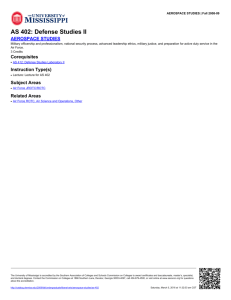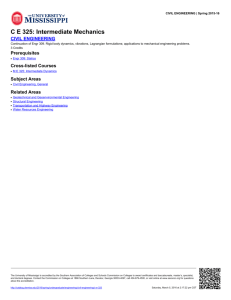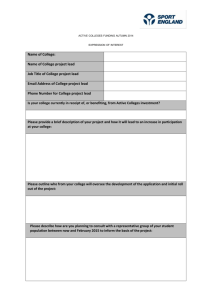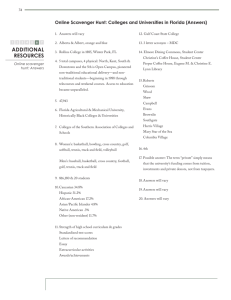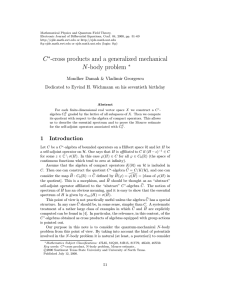Mental Health at Community Colleges
advertisement
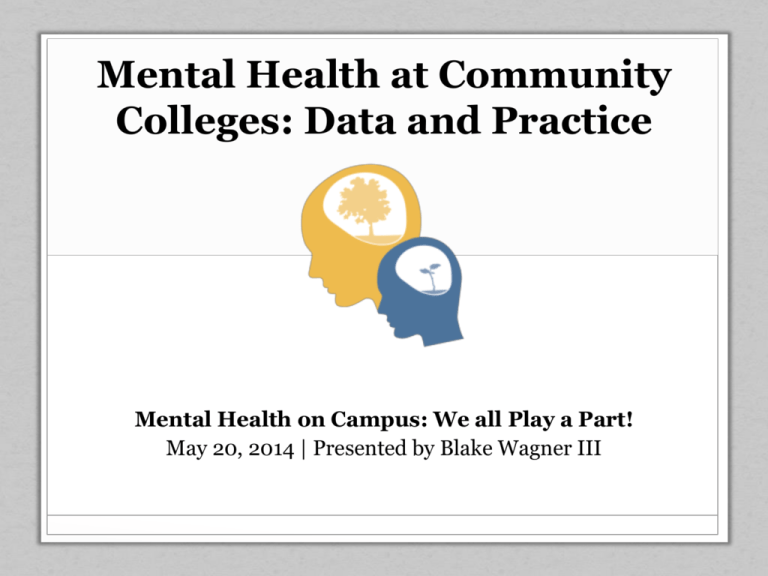
Mental Health at Community Colleges: Data and Practice Mental Health on Campus: We all Play a Part! May 20, 2014 | Presented by Blake Wagner III The Healthy Minds Network Building a collaborative, international network (1) produce knowledge (research) (2) distribute knowledge (dissemination) (3) use knowledge (practice) 2 Research-to-Practice Agenda 3 Prior Research on Community College Student Mental Health Little known about the mental health of community college students Lack of mental health resources (Wood, 2012) Top concerns of students (Gallagher, 2012): Depression Anxiety disorders Stress Wood, M. (2012). The State of Mental Health on College Campuses. Inquiry (Journal of the Virginia Community Colleges), 17(1), 5-15. Gallagher, R.P. (2012). National Survey of Counseling Center Directors. Alexandria, VA: International Association of Counseling Services. 4 Healthy Minds Study (HMS) About HMS Began in 2005 Fielded at >100 four-year campuses >100,000 survey respondents to date Main Measures Mental health (depression, anxiety, self-injury, suicidality, positive mental health) Health behaviors (e.g., substance use, exercise, sleep) Attitudes and knowledge about services Service use Academic and social environment 5 HMS at Community Colleges Winter/spring 2014 Beginning of focus on community colleges (CCs) Funding from University of Michigan and NEOMED (Ohio) Today: data from 3 CCs in Ohio Fall 2014 Consortium of ~20 CCs Funding: SingleStop USA, University of Wisconsin (Professor Sara Goldrick-Rab), Association of Community College Trustees (ACCT) Modified survey to focus on low-income students Housing and food insecurity, use of public services 6 About Today’s Data 2014 CC data 3 CCs in Ohio Invited sample=9,121 Survey completers=1,419 students Overall response rate=15.6% Comparison data from 2013 four-year schools 16 schools Invited sample=59,162 Survey completers=17,563 students Overall response rate=29.7% Adjusted for non-response bias 7 Sample Characteristics 2014 Community Colleges (N=1,419) 2013 Four-Year Institutions (N=17,563) Age (18-22) 41.2% Age (18-22) 74.6% Female 47.3% Female 53.0% White 80.7% White 72.2% 8 Prevalence of Mental Health Problems 60 Community colleges Four-year colleges/universities 50 40 37 38.9 30 20.8 20 13.3 10 0 16.7 16.1 8.7 Major Dep. (PHQ-9) 11 11.1 10.2 14.4 9.7 8.3 6 Severe Anx. (GAD-7) Mod Anx. (GAD-7) Eating Disorder (SCOFF) 16.1 13.1 Suic. Ideation Self-Injury (past yr.) (past yr.) Any MH problem Co-occurring problems CC Student Perspectives [1] “I feel anxious a lot due to the pressure and amount of school work…finding time to do the work and stay afloat financially is a burden!...I do sometimes feel so overwhelmed, stressed, and anxious, and sometimes sad…It becomes emotionally overwhelming at times and I lose motivation to do school work the next day and will procrastinate and take naps because I’m mentally drained” “I am now at a level of depression that I have isolated myself from most people. If I could afford to stay home and not work I prefer to do it but financially I have to work since I am sole provider for my two kids…I rarely see family other than my kids and I have no friends.” “Even though, most of the time I feel internally down, it doesn’t always seem that way, externally. I put on a brave face when I’m in public…but I must admit it gets pretty tough, makes me want to cry.” CC Student Perspectives [2] “School can be very stressful on students. Especially those (including myself) who have to work 45 hours a week, have a child at home, and still go to school 4 nights a week. Time management is very important.” “This year our house was foreclosed on and we have been looking for a new place, this is a very emotional time, but I am not depressed, because I do believe the living arrangements will work out.” CC Student Perspectives [3] “I have a high sense of purpose, the problem is I have not got a clue of how to fulfill that purpose. My mental health issues revolve around my financial situation and lack of it. While receiving financial aide my stress levels where down and grades where up. Now with working a job I hate, making not even enough to survive, my stress in way up and my grades are way down, just adding stress on top of stress.” “I am 36 years old and have spent, on and off, the last twenty years of my life in pursuit of a 2 year degree that will have virtually no benefit in today's saturated job market. I had a 12 year successful career that I loved, only to become medically/ physically unable to continue to perform daily tasks and had to leave the field. Because of my relentless pursuit of that now-ended career, I have approximately 2 friends within 1000+ miles and do not see or speak to them very often due to family/ class commitments. I also currently work in a dead-end position for a company that does not value their employees in any regard (benefit cuts in every possible way, constant layoffs, 5-7x increased workload with no salary increase for anyone in 6 years, poorly maintained building, etc.) As such, I have felt frustrated and fed up with pretty much all aspects of life aside from my family (loving wife and 3 yr old child) with very little outlet for release or clear direction towards the future. Therefore I have little to no sense of purpose at the moment.” Therapy among Students with Apparent Need 100 Community colleges 90 Four-year colleges/universities 80 70 60 50 40 37.7 42.7 45.5 39.7 31.7 39.1 31.5 31.1 30 27.227.3 31.232.8 28.9 30 34.836.6 20 10 0 Major Dep. (PHQ-9) Severe Anx. (GAD-7) Mod. Anx. (GAD-7) Eating Disorder (SCOFF) Suic. Ideation Self-Injury (past yr.) (past yr.) Any MH problem Co-occurring problems Medication among Students with Apparent Need 100 Community colleges 90 Four-year colleges/universities 80 70 60 50 40 50.1 46.1 34.7 44.4 41.4 36.2 35.6 27 30 49 46.2 38.5 36.1 31 25.4 25.4 24.9 20 10 0 Major Dep. (PHQ-9) Severe Anx. (GAD-7) Mod. Anx. (GAD-7) Eating Disorder (SCOFF) Suic. Ideation Self-Injury (past yr.) (past yr.) Any MH problem Co-occurring problems Any Treatment among Students with Apparent Need 100 Community colleges 90 Four-year colleges/universities 80 70 60 50 56.6 50.9 60.4 53.5 60.2 55.7 51 43.9 49 46.1 38.5 40 59 47.6 42.5 48.5 40.4 30 20 10 0 Major Dep. (PHQ-9) Severe Anx. (GAD-7) Mod. Anx. (GAD-7) Eating Disorder (SCOFF) Suic. Ideation Self-Injury (past yr.) (past yr.) Any MH problem Co-occurring problems Any Treatment among Students with Apparent Need (ages 18-22) 100 Community colleges 90 Four-year colleges/universities 80 70 60 50 50 40 52.952.6 52.7 51.1 42.942.8 40.4 33.1 38.1 50.5 46.9 48.3 41.6 37.438.9 30 20 10 0 Major Dep. (PHQ-9) Severe Anx. (GAD-7) Mod. Anx. (GAD-7) Eating Disorder (SCOFF) Suic. Ideation Self-Injury (past yr.) (past yr.) Any MH problem Co-occurring problems CC Student Perspectives [4] “This inspired me to seek information at my campus regarding mental health.” “Mental health is a troubling subject for many more students than it appears. Addressing the problem correctly would require more than access to counseling, but the introduction of acceptance and understanding from the staff.” Treatment Barriers among CC Students with Apparent Need 60 50 40 51.4 42.3 41.8 32.7 35.3 32.5 30 20.2 20 21.7 19.5 24.2 10 0 Have not Prefer to Financial No time had any deal on reasons need my own Worry Question Problem Question Stress is Social what whether will get how normal in support others tx is better by serious school will think helpful itself my needs are CC Campus Climate [1] At my school, I feel that the academic environment has a negative impact on students' mental and emotional well-being. Any mental health problem 70 60 50 40 30 20 10 0 No mental health problem 40.3 33 37.7 27.3 15.6 13.2 10.6 6.3 3.7 Strongly agree Agree Neither agree nor disagree Disagree 12.4 Strongly disagree CC Campus Climate [2] At my school, I feel that the campus climate encourages free and open discussion about mental and emotional health. Any mental health problem 70 60 50 40 30 20 10 0 51.5 18.5 4.8 No mental health problem 56.9 24.4 16.5 10 7 Strongly agree 8.8 1.7 Agree Neither agree nor disagree Disagree Strongly disagree Applying these Findings in Practice Quantify problems, identify opportunities Evaluate programs Advocate for resources (and establish economic case) Next Steps for HMN’S CC Research Modified HMS survey at ~20 schools in fall 2014 Examine links between mental health and: Food insecurity Housing insecurity Financial stress in general Use of supportive services and benefits Academic outcomes Intervention research inkblots & tinyshifts • Current projects • Next steps • Ways your school can get involved! • Tomorrow’s webinar on social media use and mental health: Wednesday, May 21, at 11:30am-12:30pm (ET) • RSVP: healthyminds@umich.edu Contact Information HMN Team: healthyminds@umich.edu Web: healthymindsnetwork.org Mental Health at Community Colleges Presented at Mental Health on Campus: We All Play a Part Ohio Program for Campus Safety & Mental Health Columbus State Community College May 20, 2014 Kevin P. Kuntz, M.A.Ed., PCC-S, NCC Counselor/Assistant Professor Ky Heinlein, Ph.D., LPCC-S Counselor/Assistant Professor David Nardecchia, M.Ed., LPCC Counselor/Assistant Professor Samantha J. Posey, M.A.Ed., PCC-S Counselor/Assistant Professor 25 Facts & Statistics • The National Institute of Mental • Young adults aged 18-24 have Health estimates that one in five the highest prevalence of Americans 18 and older suffer diagnosable forms of mental from a diagnosable mental illness among the entire health disorder in any given population, at 27%. year. • An estimated 26 percent of Americans ages 18 and older – about 1 in 4 adults - live with a diagnosable mental health disorder in a given year. • Nearly ¾ of people with anxiety disorders will have their first episode by age 21. • Compared to older adults, the 18-24 yr old age group shows the lowest rate of help-seeking behaviors. • Suicide is the 2nd leading cause of death among college students, claiming the lives of 1,100 students each year. 26 www.activeminds.org Facts & Statistics Continued • The American College Counseling Association Community College Task Force (2011) conducted a survey of community /2-year college counseling services and these are a few of their findings: • 71% report having a Threat Assessment Team on site • 43% do not offer any suicide prevention • 60% describe an increase in the intensity/severity of clinical issues, relative to past years 27 Call to Counselors • Help! Students are not doing their work! They are not focused! • Along comes the increased need for instructional faculty education regarding mental health issues. The students’ behavior is disguised as “disruptive behavior”, while in reality there is a life cycle transition occurring and quite possibly a mental health concern occurring. 28 WHO Do We See at Community College • First generation college student • First time college students • High-at-risk students • LGBTQ • Students with pre-existing mental health disorders • Students with emerging chronic mental health disorders (schizophrenia, bipolar...) • International students • Returning veterans 29 • Low socioeconomic income WHAT Do We See? • Stress • Anxiety • Depression • Emerging chronic mental health disorders • Grief and loss • Relationship problems • Academic problems 30 (ACCA, 2011) Cuyahoga Community Counseling Faculty are doing multi-level outreach to increase Mental Health Awareness. 31 Student Outreach • Provide education and support through: • Mental Health Awareness workshops and classes • Depression Screenings • Mental Health Awareness Week • availability of Mental Health educational brochures • Active Minds • Connect with NAMI 32 and other supports College/Community Outreach Feature National speaker to present about suicide prevention Provide Mental Health and Suicide Awareness trainings to: • Full Time Instructional Faculty • Adjunct Instructional Faculty • College Administrators Work together to provide support to identified students 33 Professional Engagement • Conduct research • Serve as member/ officer to professional organization • Present at professional conferences • Local • State • National 34 Challenges (Anderson, 2013) • Limited time on campus • Self-doubt or uncertainty • Part-time student • Limited supports • Low income • Limited transportation • Instructional faculty who do not find attending to mental health needs important • Work full time • Mental health stigma 35 Resources • Edwards, J. (2011). American College Counseling Association: Community College Task Force. Survey of community /2 year college counseling services.Supervised by Amy Lenhart. • Michelle Dykes-Anderson (2013)The Case for Comprehensive Centers at Community Colleges, Community College Journal of Research and Practice, 37:10, 742-749, DOI:10.1080/106689210037235 • Abuse and Mental Health Services Administration http://www.samhsa.gov/ The Jed Foundation - http://www.jedfoundation.org/ Suicide Prevention Resource Center - http://www.sprc.org/ American Foundation for Suicide Prevention - http://www.afsp.org American Association of Suicidology - http://www.suicidology.org The Trevor Project - http://www.thetrevorproject.org/ Active Minds - http://www.activeminds.org/ National Alliance on Mental Illness - http://www.nami.org/ Give an Hour - http://www.giveanhour.org/ • • • • • • • • 36 Questions? Kevin P. Kuntz, M.A.Ed., PCC-S, NCC Counselor/Assistant Professor Kevin.Kuntz@tri-c.edu Ky Heinlen, PhD, LPCC-S Counselor/Assistant Professor Kathleen.Heinllen@tri-c.edu David Nardecchia, M.Ed., LPCC Counselor/Assistant Professor David.Nardecchia@tri-c.edu Samantha J. Posey, M.Ed., PCC-S Counselor/Assistant Professor Samantha.Posey@tri-c.edu 37


